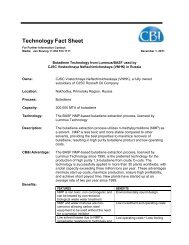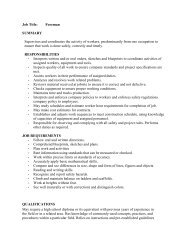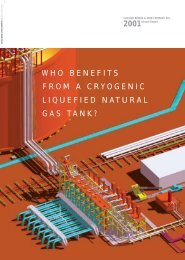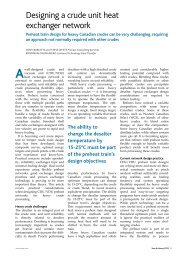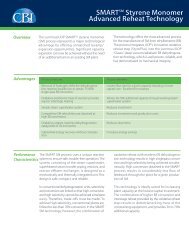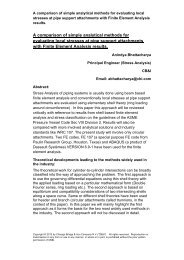In this issue - CB&I
In this issue - CB&I
In this issue - CB&I
You also want an ePaper? Increase the reach of your titles
YUMPU automatically turns print PDFs into web optimized ePapers that Google loves.
Coke Drums Designed for Longer Life<br />
Technology & <strong>In</strong>novations<br />
The bulging and eventual cracking of coke drums in the vicinity of their<br />
circumferential weld joints creates a maintenance and reliability<br />
problem that has plagued refineries for decades. So when CB&I decided<br />
to address <strong>this</strong> challenge, we developed an innovative solution that<br />
didn't just reduce bulging and cracking in the circumferential weld<br />
seam, it eliminated the seam altogether, leading to the production of<br />
vessels with a longer operating life and lower maintenance costs. The<br />
solution:Vertical Plate Coke Drums.<br />
The Bulging and Cracking Phenomenon<br />
<strong>In</strong>dustrial petroleum coke is a solid coal-like substance used primarily as<br />
a fuel for the production of anodes, electrodes, graphite or similar<br />
carbon-based products. Petroleum coke is produced by delayed<br />
coking, a batch process in which heavy residual feedstocks are<br />
superheated and introduced into a vertically oriented cylindrical “coke<br />
drum,” where the vapors are removed for further processing, leaving<br />
behind a high-density hydrocarbon residue. This residue, referred to as<br />
petroleum coke, is then water quenched to allow for its removal once<br />
the vessel has been depressurized, as well as to cool it to a point where it<br />
will not self-ignite when exposed to air. This severe operational thermal<br />
cycling experienced in the coke drums during the delayed coking<br />
process is what tends to be the primary cause of the bulging and<br />
cracking that occurs over time. Depending on the operating<br />
parameters, type of coke produced, feedstock and other variables, the<br />
cycle time of a given unit can last anywhere from 14 to 36 hours. And<br />
while it is recognized that a shorter, more severe cycle hastens the onset<br />
of bulging and cracking, in order to meet the demand for coke<br />
production (which has steadily increased due to the processing of<br />
heavier crudes), few refinery owners have the option of increasing cycle<br />
times. <strong>In</strong>stead, they must resort to either shortening their coking cycles,<br />
adding more vessels or doing both. Thermal and stress analyses have<br />
shown that the bulging and cracking phenomenon is related to the<br />
higher-strength weld metal in the circumferential girth seams, which<br />
does not yield at the same rate as the base material. The resulting<br />
stiffening effect causes a “constrained balloon shape”. Because of <strong>this</strong><br />
restraint, the base materials begin to weaken and ultimately fail due to<br />
cracking. The bulging is most severe in the lower cylindrical portion of<br />
the coke drum, where the shell is thickest.<br />
Developing a Solution<br />
Over the years, the coking industry has developed or proposed<br />
numerous solutions for alleviating the stiffening effect of the<br />
circumferential weld seams and increasing vessel life, including: “blend<br />
grinding” the weld profile, decreasing the weld metal strength to be<br />
within a closer percentage of the base metal yield, specifying higher<br />
alloy material, requiring more non-destructive examinations and a<br />
stricter acceptance criteria, and maintaining a uniform shell thickness<br />
throughout the vessel. While certain approaches have some technical<br />
merit, the majority of them typically resulted in cost increases and<br />
limited success. To develop a more reliable coke drum design, CB&I<br />
focused on eliminating the circumferential weld seam altogether.<br />
Previous research had shown that the longitudinal weld seams required<br />
to make the shell courses were seemingly unaffected by the thermal<br />
cycling, except where those seams intersected the circumferential<br />
ones. By incorporating <strong>this</strong> knowledge, along with our technical<br />
expertise and experience from other applications, we created a process<br />
for successfully fabricating shell plates that could reach lengths of up to<br />
46 feet without a circumferential weld seam. Depending on plate size<br />
limitations, up to five circumferential weld seams can be eliminated,<br />
resulting in a more reliable coke drum that can endure the most severe<br />
thermal cycles and outlast any traditional vessel currently in operation.<br />
The concept is applicable not only to new construction (shop built or<br />
field erected) projects, but also to retrofit applications, where the lower<br />
cone and top head sections are reused. We have patented our Vertical<br />
Plate Coke Drum technology in the United States, and patent coverage<br />
Vertical Plate Coke Drum Applications<br />
Since 2000, CB&I has completed four Vertical Plate Coke Drum retrofit<br />
projects, all of which were completed at an equal or lower cost to the<br />
customer than traditional methods and were much less expensive than<br />
full-vessel replacement. The first successful installation took place at a<br />
refinery in the western United States in 2000.<br />
The client had originally planned on replacing two 20-foot-plus<br />
sections of distorted and cracked shell on two of its coke drums, which<br />
would have left circumferential seams in the section of the drum where<br />
the bulging and cracking was most pronounced. However, after<br />
reviewing CB&I's vertical plate concept, the client decided to modify its<br />
plan and replaced all but the upper nine feet of shell with two vertical<br />
plate courses reaching heights of 23.5 feet and 40 feet, respectively.<br />
The vertical plates are lifted into place at a refinery in<br />
the western United States.<br />
<strong>In</strong> addition to forming and welding the plates and erecting the vessels<br />
concurrently on a turnaround basis, CB&I also replaced a large nozzle in<br />
the top head and sections of the skirt support, and performed postweld<br />
heat treating and hydrostatic testing all within a span of 28 days.<br />
The vertical plate solution was so successful, the client subsequently<br />
contracted CB&I to replace the shells on an additional four coke drums.<br />
Overall, CB&I has completed a total of 11 Vertical Plate Coke Drums.<br />
These projects have included the full circumferential can section<br />
replacement of shells ranging from 35 to 73 feet, as well as new lower<br />
knuckle and skirt assemblies. Currently, we are pursuing several other<br />
coke drum projects, including some that require a full coke drum<br />
replacement to add to the refinery's existing coke drum production.<br />
Replacing an entire vessel involves removing the derrick on top of the<br />
structure with one lift and then removing the damaged coke drum and<br />
setting the new one into place.<br />
It is a unique process that requires extensive planning and<br />
coordination, but one that we have the expertise to execute. As<br />
feedstocks become heavier and the need for increased coking capacity<br />
continues to rise, refiners will need more than ever to have coke drums<br />
that last longer and come at no greater cost than traditional methods.<br />
CB&I has developed what is probably the most cost-effective solution<br />
to meet those needs. Whether it is a retrofit application or a full vessel<br />
replacement, we believe our Vertical Plate Coke Drums will be able to<br />
endure the most severe thermal cycles and outlast any conventionally



